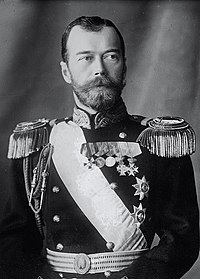
Back Keiser van die Hele Rusland Afrikaans إمبراطور عموم روسيا Arabic Бөтә Рәсәй Императоры Bashkir Імператар Усерасійскі Byelorussian Імпэратар Усерасейскі BE-X-OLD Emperador de totes les Rússies Catalan Gosudar-imperátor Czech Russischer Kaiser German Αυτοκράτορας Πασών των Ρωσιών Greek Emperador de todas las Rusias Spanish
| Emperor and Autocrat of all Russia | |
|---|---|
| Император и Самодержец Всероссийский | |
Imperial | |
 Imperial Standard (1858–1917) | |
 | |
| Details | |
| Style | His/Her Imperial Majesty |
| First monarch | Peter I |
| Last monarch | Nicholas II |
| Formation | 2 November 1721 |
| Abolition | 15 March 1917 |
| Residences | Winter Palace Moscow Kremlin Peterhof Palace Catherine Palace Alexander Palace |
| Appointer | Hereditary |
| Pretender(s) | |
The emperor and autocrat of all Russia[1] (Russian: Император и Самодержец Всероссийский, romanized: Imperator i Samoderzhets Vserossiyskiy, IPA: [ɪm⁽ʲ⁾pʲɪˈratər ɪ səmɐˈdʲerʐɨt͡s fsʲɪrɐˈsʲijskʲɪj]),[a] also translated as emperor and autocrat of all the Russias,[2] was the official title of the Russian monarch from 1721 to 1917.
The title originated in connection with Russia's victory in the Great Northern War (1700–1721) and appeared as an adaptation of the tsar's title under the accepted system of titling in Europe. The title was transformed from the previous title of tsar and grand prince of all Russia. The old title tsar (or tsaritsa) continued to be popularly used to refer to the emperor (or empress) until the monarchy was abolished in 1917.
- ^ Ferro, Marc (1995). Nicholas II: Last of the Tsars. Oxford University Press. p. 36. ISBN 978-0-19-509382-7.
- ^ Stone, Bailey (2014). The Anatomy of Revolution Revisited: A Comparative Analysis of England, France, and Russia. Cambridge University Press. p. 65. ISBN 978-1-107-04572-9.
Cite error: There are <ref group=lower-alpha> tags or {{efn}} templates on this page, but the references will not show without a {{reflist|group=lower-alpha}} template or {{notelist}} template (see the help page).